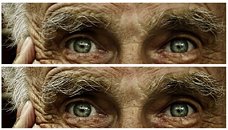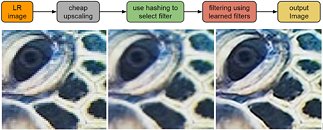- Joined
- Oct 9, 2007
- Messages
- 47,300 (7.53/day)
- Location
- Hyderabad, India
| System Name | RBMK-1000 |
|---|---|
| Processor | AMD Ryzen 7 5700G |
| Motherboard | ASUS ROG Strix B450-E Gaming |
| Cooling | DeepCool Gammax L240 V2 |
| Memory | 2x 8GB G.Skill Sniper X |
| Video Card(s) | Palit GeForce RTX 2080 SUPER GameRock |
| Storage | Western Digital Black NVMe 512GB |
| Display(s) | BenQ 1440p 60 Hz 27-inch |
| Case | Corsair Carbide 100R |
| Audio Device(s) | ASUS SupremeFX S1220A |
| Power Supply | Cooler Master MWE Gold 650W |
| Mouse | ASUS ROG Strix Impact |
| Keyboard | Gamdias Hermes E2 |
| Software | Windows 11 Pro |
The one phrase from television that makes IT people and creative professionals cringe the most is "zoom and enhance" - the notion that you zoom into a digital image and, at the push of a button, it converts a pixellated image into something with details - which lets CSI catch the bad guys. Up until now, this has been laughably impossible. Images are made up of dots called pixels, and the more pixels you have, the more details you can have in your image (resolution). Zooming into images eventually shows you a colorful checkerboard that's proud of its identity.
Google is tapping into machine-learning, in an attempt to change this. The company has reportedly come up with a machine-learning technique that attempts to reconstruct details in low-resolution images. Google is calling this RAISR (rapid and accurate image super-resolution). The technology works with the software learning "edges" of a picture (portions of the image with drastic changes in color and brightness gradients), and attempts to reconstruct them. What makes this different from conventional super-sampling methods is its machine-learning component. A low-resolution image is studied by the machine to invent an upscaling method most effective for the image, in-situ. While its application in law-enforcement is tricky, and will only become a reality when a reasonably high court of law sets a spectacular precedent; this technology could have commercial applications in up-scaling low-resolution movies to new formats such as 4K Ultra HD, and perhaps even 8K.



View at TechPowerUp Main Site
Google is tapping into machine-learning, in an attempt to change this. The company has reportedly come up with a machine-learning technique that attempts to reconstruct details in low-resolution images. Google is calling this RAISR (rapid and accurate image super-resolution). The technology works with the software learning "edges" of a picture (portions of the image with drastic changes in color and brightness gradients), and attempts to reconstruct them. What makes this different from conventional super-sampling methods is its machine-learning component. A low-resolution image is studied by the machine to invent an upscaling method most effective for the image, in-situ. While its application in law-enforcement is tricky, and will only become a reality when a reasonably high court of law sets a spectacular precedent; this technology could have commercial applications in up-scaling low-resolution movies to new formats such as 4K Ultra HD, and perhaps even 8K.



View at TechPowerUp Main Site






